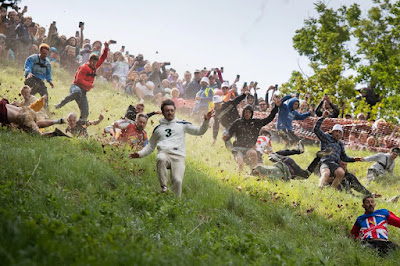Annual events can originate from traditional customs, religious rituals, social media trends, even out of sheer boredom. In this article, we will talk about Top 10 Most Unusual Festivals from Around the World ! Let's get started!
10. Bunyol Tomato Fight (La Tomatina), Spain:
La Tomatina is a unique and exciting festival held in Buñol, Spain, on the last Wednesday of August every year. It is known for its massive tomato fight, where participants throw tomatoes at each other in a gigantic food fight. The festival has been held since 1945 and has become an official event since 1957. Despite being banned in the 1950s by Francisco Franco due to its lack of religious importance, the festival has been allowed with more participants.
9. Up Helly Aa, Scotland:
Up Helly Aa is a annual fire festival in Shetland, Scotland, held from January to March to mark the end of the Yule season. It involves a torchlit procession by costumed participants, known as guizers, culminating in the burning of an imitation Viking galley. The largest festival is held in Lerwick, the capital, and attracts thousands of visitors. Originating from the older yule tradition of tar barrelling, the festival showcases Shetland history, community spirit, and the skills of the guizers.
8. Cheese Rolling Festival, England:
The Cheese Rolling Festival is an annual event in England, dating back to the 15th century, where people chase a wheel of cheese down a steep hill. The event, held on the last Monday in May. The cheese is a round of Double Gloucester cheese, weighing 9 pounds and reaching speeds of up to 70 miles per hour. The festival attracts thousands of spectators and competitors, dressed in costumes or funny hats, and celebrates local culture with music, dancing, food, and drinks. The event is not officially organized or sanctioned, relying on volunteers and donations.
7. Monkey Buffet Festival, Thailand:
The Monkey Buffet Festival is a unique event held annually in Lopburi, Thailand, to honor the local monkey population and their role in the town's culture and history. The festival takes place on the last Sunday of November at the Phra Prang Sam Yot temple. The festival features a buffet of fruits, vegetables, nuts, rice, and desserts prepared by local chefs and volunteers, weighing over 4,000 kilograms.
6. La Calavera Catrina Parade, Mexico:
The La Calavera Catrina Parade is a colorful event in Mexico City, usually held in late October, as part of the Day of the Dead celebrations. The parade features thousands of people dressed as La Catrina, the iconic skeleton woman, representing the idea that death is the great equalizer. The parade is a tribute to Mexican culture, history, and the cycle of life and death. Participants wear elaborate costumes, carry flowers, candles, skulls, and other Day of the Dead symbols.
5. The Thaipusam Festival, Malaysia:
Thaipusam is a Hindu festival celebrated by the Tamil community in Malaysia, primarily in the Batu Caves. It commemorates the occasion when Lord Murugan received a divine spear to vanquish evil forces. Devotees pay homage to Lord Murugan through acts of devotion and penance, including the kavadi procession. The Batu Caves, a series of caverns and temples, become the focal point of the festivities, culminating with 272 steps to reach the temple. The festival is also celebrated in Singapore, India, Sri Lanka, and other countries with significant Tamil communities.
4. Hadaka Matsuri (Naked Festival), Japan:
Hadaka Matsuri, also known as the Naked Festival, is a traditional Japanese event where thousands of male participants, dressed in loincloths, compete for sacred talismans. The festival, rooted in purification rituals, is believed to bring good luck and ward off illness. The event attracts large crowds and showcases a blend of ancient rituals and modern practices in Japan, attracting participants and spectators alike.
3. Night of the Radishes (Noche de Rabanos), Mexico:
The Night of the Radishes, or "Noche de Rabanos," is a Mexican festival on December 23rd featuring intricate radish carvings. Originating in the 19th century, it attracts locals and tourists alike. The festival features a competition where artisans showcase their radish-carving skills, often using other vegetables and natural materials. Judges evaluate the carvings, and prizes are awarded for the most impressive ones. The event blends artistry, agriculture, and cultural expression, attracting visitors and local artists alike.
2. International Highline Meeting Festival, Italy:
The International Highline Meeting Festival is an annual event in Monte Piana, Dolomites, Italy, combining highlining with breathtaking mountain scenery. Participants set up their lines across the stunning mountain landscape, enjoying camaraderie. The festival is not just for experienced highliners but also offers newcomers a safe and supervised environment to learn from seasoned practitioners. It provides an opportunity for enthusiasts to connect and enjoy the beauty of the Dolomites.
1. Holi, India:
Holi, also known as the Festival of Colors or the Festival of Love, is a vibrant Indian festival celebrated with enthusiasm across the country and globally. It signifies the arrival of spring, the victory of good over evil, and a time for love and joy. The festival begins with Holika Dahan, a ritual where bonfires are lit, followed by dousing each other in colored powders and water, singing, and dancing. Holi transcends social boundaries, bringing people of all backgrounds together. Different regions in India have unique ways of celebrating, including cultural performances, music, and special dishes.
The journey through these festivals showcases human creativity, heritage, and unity, representing different aspects of global culture. They highlight the shared desire for connection, expression, and joy, underlining the universality of human celebration and the beauty in our differences. May these vibrant and diverse festivals continue to remind us.











Comments
Post a Comment